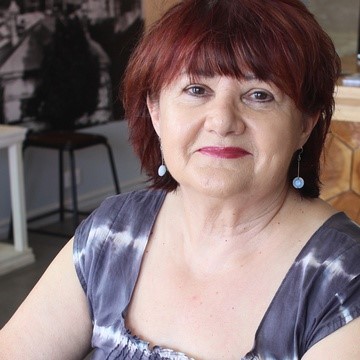
I was fortunate to meet Perth-based author Susan Midalia during a short story workshop she presented when I was chairperson of Rockingham Writers Centre, and I was immediately struck by the depth of her knowledge, her well-honed talent for teaching, and the warmth of her wit. I also had the pleasure of hearing her speak about her short story writing when she was a guest for the Stories on Stage series of author talks, at Koorliny Arts Centre — and I may have headed home with signed copies of each of her story collections cradled in my arms. When I started reading the most recent of these collections, Feet to the Stars (UWA Publishing), I experienced the gamut of emotions — her writing is lyrical and evocative, and the human frailties of her characters clutch at the heart strings. No surprise, then, that I was easily convinced to read her debut novel, The Art of Persuasion (Fremantle Press), and to interview her in a Q&A format for Good Reading magazine. At the same time, I took the opportunity to invite Susan to be my guest on Shelf Aware — and was chuffed when she agreed.
The Art of Persuasion is a modern take on the literary works of Jane Austen, and might be described as a contemporary literary romance and comedy of manners — with a touch of politics on the side. At the start of the novel, heroine Hazel West is unemployed, unattached and in the midst of a crisis of confidence, but by the end of the book her life is considerably brighter. Hazel’s apparent love interest is widower and father Adam, who conjures associations with classic romantic heroes Captain Wentworth, Mr Darcy and Mr Knightley, yet has his ideologies firmly planted in the 21st Century. Hazel has a tendency toward pessimism and self-indulgence, while Adam borders on patronising and his moods are changeable, yet the chemistry between this characters is palpable, and their imperfections imply that they just might be perfect for one another. For me, this novel was a joy from the first to the last page, and I found Susan’s answers to my Shelf Aware questions also highly entertaining. And I’ve managed to add quite a number of new names and titles to my ‘to read’ pile, after seeing Susan’s list of favourite writers and books. I recommend you find a comfortable place to sit back and enjoy getting to know Susan Midalia through the books on her shelves.
Q. Susan, how would you describe the work that you do and how you do it?
A. Having written three collections of short stories, and more recently a novel, I am well-versed in the art of writing slowly and arduously, painstakingly attentive to every word and sentence. I don’t mean by this that the process is unpleasant; on the contrary, writing fiction is one of the most pleasurable experiences I’ve had in the various incarnations of my life. It’s the mind, heart and body working together to make my writing the best it can be.
I’m particularly interested in individual psychology, both the conscious and the unconscious self, of people who are very different from me: a middle-aged, middle-class educated woman, happily married, and the mother of two adult sons. How do I imagine such creatures? I gain my knowledge partly from many years of reading wonderful fiction, and partly through my observations of people in real life. I’m especially interested in what people say, and don’t say: the ways in which language reveals or obscures their desires and fears, their motives and degree of self-awareness. I’m also interested in the idea of choice, which always takes place in the complex and particular contexts of class, gender, culture and race. Doing this fascinating work requires extended and reflective time, and I have the luxury of being able to write all day, every weekday, if the inclination hits me. My husband tells me I’m enormously self-disciplined, but in fact I don’t need to make myself write. It’s a beautiful, joyful compulsion.
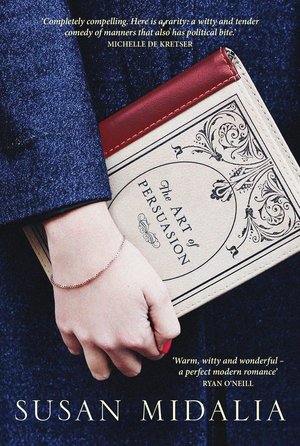
Q. What is your latest project, and/or what do you have in the pipeline?
A. I’m currently working on another novel. The first draft didn’t take me long at all – maybe six months – but I’ve since re-written large sections, and added another major character. Now I’m working on style: checking every word for precision and nuance, making choices about the sounds of words and the rhythms of sentences; adding commas, taking them out. Every writer knows how this goes! It’s a novel in four different voices: a middle-aged married couple (miserable in their marriage), their former daughter-in-law and her twelve-year-old child. I’m exploring family, love, mental illness and the possibility of recovery.
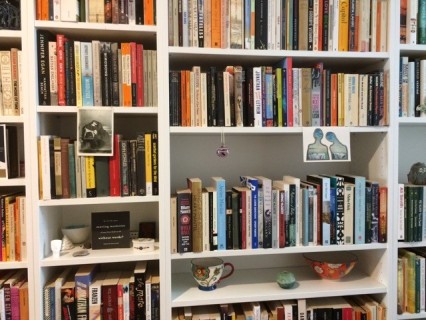
Q. Where are the main bookcases in your home or office? Do you also keep books in other places at home (or elsewhere)?
A. Ah, books! There are books all over our apartment. Most of them are in my study, on floor-to-ceiling bookcases, built by my patient, generous husband. There are also free-standing bookcases in my study, plus more books in the living room and the spare bedroom. When we downsized a couple of years ago, from an old house to an apartment, I took the opportunity to cull books accumulated over decades, but alas, I didn’t pass on as many as I should have. I love the feeling of being surrounded by books; it helps me to remember that a great tradition of writing precedes me, and that there are terrifically good writers currently producing literary treasures.
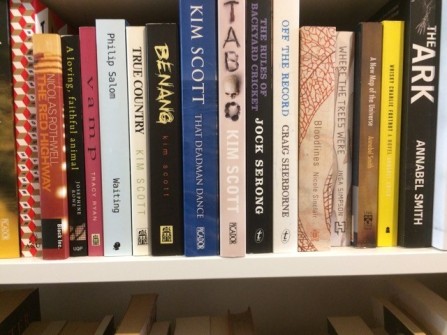
Q. How are your books organised/arranged?
A. I have so many books that organisation is essential. I have sections for specific genres, and I arrange them alphabetically. Novels by Australian writers; non-Australian writers; short stories by writers from all over the world; biography, autobiography and memoir; poetry; antiquarian books; non-fiction; and a special shelf for feminist non-fiction. The living room houses my favourite hardback novels and short story collections, and here I have a shameful confession: when we were putting our old house on the market, the agent suggested colour-coding the hardbacks for a pleasing aesthetic effect (i.e. it would look good in the promotional photos). I was initially snobbishly repelled by what I saw as a slick real estate strategy, but one night, I decided – just for fun – to take up the agent’s suggestion. The result: it looks fabulous, darling! I’ve even arranged those handsome hardbacks according to their height. Friends have been variously amused, impressed, and critical of me for having sold out to the capitalist juggernaut. But I like the way they look!
Q. What sorts of books predominate?
A. Definitely fiction: novels and short stories. I’d say roughly 90% fiction, 10% the rest. I used to tell myself to broaden my preferences, but as I’ve aged, I’ve become more inclined to stick with my favourite genres. As they say, life is short and art is long, and there are too many great novels and stories I haven’t yet read to feel guilty about my reading tastes.
Q. Describe your favourite reading place.
A. I have two. One is the beanbag in my study. I used to own a beanbag when they were all the rage in the 60s, and I bought another one to celebrate the publication in 2007 of my first collection of stories, A History of the Beanbag (of course). The one I use now is new, blue and enfolding. The only problem is the noise that sometimes comes from neighbours in a downstairs apartment – loud yacking on the balcony, raucous laughter. When that happens, I read in bed. I love reading propped up by big pillows, with a cup of tea or glass of wine on the bedside table.
Q. What book/s are you reading right now? Why did you choose that book/those books and what do you think of it/them so far?
A. I choose books on the recommendations of friends and my favourite booksellers; based on reviews; and new Australian fiction so I can keep up with, and support, the Australian literary culture. I also browse in bookshops, when I always read the first couple of pages to decide whether the writing is any good. If I find one cliché, a poorly chosen metaphor, clunky, tin-eared rhythms, or overwriting, I won’t buy the book. What matters to me isn’t the subject matter but the quality of the writing; I have to be able to trust the author, to know that I’m in safe hands.
What have I read recently? A number of Australian novels have impressed me. Gail Jones’s forthcoming The Death of Noah Glass is a remarkably intelligent exploration of the value of art; different forms of love; the pathos of fatherhood; and the strategies of crime. It’s classic Jones: dauntingly cerebral but also deeply affecting, and written with her usual stylistic audacity and poise. I also enjoyed David Dyer’s The Midnight Watch, about the history of the investigation into the sinking of the Titanic: meticulously researched, imagistically dense, psychologically astute. It had rave reviews in America, but seems to have sunk in Australia (forgive the terrible pun). I was also engaged by Ceridwen Dovey’s In the Garden of The Fugitives in the Garden, a novel about archeology and romantic obsession, written in epistolary form: a great way to reveal the psychology of character with subtlety and flair. Michelle de Krester’s The Life to Come is an absorbing exploration about the life of art, the complexities of different cultures and the complications of family. I love the mix of withering satire and pathos.
I’ve been similarly impressed by number of debut novels by Australian writers. I was required to read them to facilitate sessions at the recent Perth Writers Week, but it didn’t feel like a duty: I genuinely loved them all. Laurie Steed’s You Belong Here is a deftly written and beautifully understated account of broken families and the possibility of healing. Melbourne writer Robert Lukins’ The Everlasting Sunday is both an achingly tender and visceral depiction of youthful masculinity under siege. Paul Collis’s Dancing Home is a confronting, brutal and intensely poignant “road trip” about the victimization of Indigenous people in contemporary Australia.
Internationally: in the past few months I’ve read George Saunders’ Lincoln in the Bardo, one of the most formally inventive novels I’ve read in many years, and always unexpected in its tonal shifts. Jenny Erpenbeck’s Go, Gone, Went (translated from the German), an illuminating and emotionally affecting account of the current refugee crisis in Berlin. Brilliant! Samanta Scweblin’s novella Fever Dreams (translated from the Spanish): a psychological horror story about maternal obsession and environmental devastation. Rivetting! Kamila Shamsie’s Home Fire: an ethically circumspect page-turner about the making of a terrorist, and the damage this leaves in his wake. I’m currently reading a superb collection of short stories by Queensland writer Laura Elvery called Trick of the Light: always surprising, and cleverly written, with a strong sense of different voices.
Q. What are your favourite books and/or who are your favourite authors?
A. There are so many others I could name, but here goes:
Short story writers I admire: Claire Keegan, George Saunders, Lorrie Moore, Joyce Carol Oates, Alice Munro, Vincent O’Sullivan, Janet Frame, Raymond Carver, Anne Enright, Carol Shields and Mavis Gallant.
Australian novelists: Gail Jones, Michelle de Kretser, Amanda Curtin, Sonya Hartnett, Mireille Juchau, Joan London, David Malouf, Patrick White, Randolph Stow and Christina Stead.
International novelists: Charles Dickens, Jane Austen, Charlotte Bronte, Thomas Hardy, George Eliot, Henry James, E.M. Forster, James Joyce, Fydor Dostoevsky, Virginia Woolf, E.L. Doctorow, Michael Cunningham, Don DeLillo, Jennifer Egan, Michel Faber, Carol Shields, Ali Smith, Zadie Smith, Hilary Mantel, Anne Tyler, Maggie O’Farrell, Toni Morrison, Colum McCann, Colm Toibin, Joyce Carol Oates, Deborah Levy and Rachel Cusk.
My favourite poets: Thomas Hardy, Seamus Heaney, Adrienne Rich, William Shakespeare, Lucy Dougan, Carolyn Abbs, Simon Armitage, W.H. Auden, Frank O’Hara and Fay Zwicky.
My three favourite books: Henry James’ Portrait of a Lady, for its psychological and moral complexity, and the precision of the prose. It was the first “grown-up” novel I remember reading because it made me aware that the best books raise questions instead of providing easy answers to the complex business of living.
Gail Jones’ Five Bells, for the pleasure of its poetic prose, the intelligent understanding of history and its sensual evocation of place.
L.M. Montgomery’s Anne of Green Gables, for its creation of a feisty heroine, its understanding of grief, and its depiction of female friendship. I first read it when I was twelve, and recently re-read it, to discover I hadn’t realised as a twelve-year-old how beautifully it’s written.
Q. In the event of an emergency, if you could save just three books from your collection, which books would they be – and why would you choose them?
A. Books as words on a page, bound into a volume, are usually replaceable, but memories are not. So I’ve chosen three books to rescue in an emergency because of their personal associations. They’re in chronological order of acquisition.
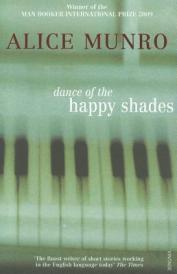 One: Alice Munro’s first short story collection, Dance of the Happy Shades, published in 1968. I bought the book in anticipation of Alice Munro’s visit in 1978 to the English Department at the University of Western Australia, where I had my first job as a full-time tutor. I was invited to a staff lunch, and through some thunderbolt of good fortune, found myself next to the incomparable Alice Munro, by that stage the author of four acclaimed collections. I remember very little of our conversation because I was anxious and tongue-tied, but I do remember her softly spoken voice, her gracious manner, and the fact that one particular story in Dance of the Happy Shades turned out to be our absolute favourite. I like to think she wasn’t merely being kind to a naïve young woman, but the book remains precious to me because of her gentle presence on that day, and because she helped me to realise that famous people are not necessarily crassly self-promoting and arrogant.
One: Alice Munro’s first short story collection, Dance of the Happy Shades, published in 1968. I bought the book in anticipation of Alice Munro’s visit in 1978 to the English Department at the University of Western Australia, where I had my first job as a full-time tutor. I was invited to a staff lunch, and through some thunderbolt of good fortune, found myself next to the incomparable Alice Munro, by that stage the author of four acclaimed collections. I remember very little of our conversation because I was anxious and tongue-tied, but I do remember her softly spoken voice, her gracious manner, and the fact that one particular story in Dance of the Happy Shades turned out to be our absolute favourite. I like to think she wasn’t merely being kind to a naïve young woman, but the book remains precious to me because of her gentle presence on that day, and because she helped me to realise that famous people are not necessarily crassly self-promoting and arrogant.
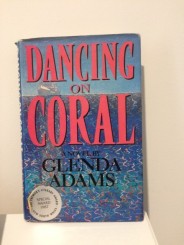 Two: Glenda Adam’s Dancing on Coral, published in 1988. It’s a beautifully produced hardback, although now slightly yellowing, and it’s precious because of my having met Glenda at a conference in Brisbane for The Australian Association for the Study of Australian Literature. I remember, for example, travelling on the conference bus with her, and having thoughtful, lively conversations and a lot of laughs. She was unfailingly modest, generous to the young like me, and an example of an author dedicated to her craft without being precious or pretentious. Our other travelling companion on that companionable bus was my then boyfriend, Dan Midalia, soon to become my husband of nearly forty years; he too remembers Glenda with much affection. We were saddened to hear that she’d died at relatively young age of 67, but I will always treasure the outlandish wit and love of language of Dancing on Coral.
Two: Glenda Adam’s Dancing on Coral, published in 1988. It’s a beautifully produced hardback, although now slightly yellowing, and it’s precious because of my having met Glenda at a conference in Brisbane for The Australian Association for the Study of Australian Literature. I remember, for example, travelling on the conference bus with her, and having thoughtful, lively conversations and a lot of laughs. She was unfailingly modest, generous to the young like me, and an example of an author dedicated to her craft without being precious or pretentious. Our other travelling companion on that companionable bus was my then boyfriend, Dan Midalia, soon to become my husband of nearly forty years; he too remembers Glenda with much affection. We were saddened to hear that she’d died at relatively young age of 67, but I will always treasure the outlandish wit and love of language of Dancing on Coral.
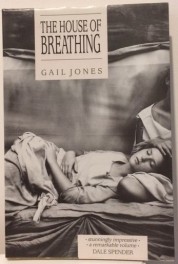 Three: Gail Jones’s first collection of short stories, The House of Breathing, published in 1992. Gail and I had become friends in the 1970s, when I was teaching at UWA and she was a student, and I became the first reader of the short fiction that she was then beginning to write. When The House of Breathing won the T.A.G. Hungerford Prize and a publication from Fremantle Press, Gail asked me to edit it. She’s since moved into the literary stratosphere, of course – as I told her once, I knew her before she became a rock star! – but my dog-eared and slightly stained copy of The House of Breathing remains of inestimable value because it symbolises our long-standing friendship, our shared love of books and writing, and our mutual respect.
Three: Gail Jones’s first collection of short stories, The House of Breathing, published in 1992. Gail and I had become friends in the 1970s, when I was teaching at UWA and she was a student, and I became the first reader of the short fiction that she was then beginning to write. When The House of Breathing won the T.A.G. Hungerford Prize and a publication from Fremantle Press, Gail asked me to edit it. She’s since moved into the literary stratosphere, of course – as I told her once, I knew her before she became a rock star! – but my dog-eared and slightly stained copy of The House of Breathing remains of inestimable value because it symbolises our long-standing friendship, our shared love of books and writing, and our mutual respect.
Q. If you could sit down for afternoon tea with your three favourite characters or authors, who would they be, what would you serve them, and what would like to talk to them about?
A. Since I’ve already given details about my favourite writers and books, I’ve chosen three characters I would invite to afternoon tea (I don’t necessarily like them):
One: Meursault, from Albert Camus’ The Outsider (translated from the French L’Etranger). I would probably serve him wine and cigarettes, because – well, he’s French and existentially cool, and eating scones and jam, or cucumber sandwiches, is clearly so bourgeois. What I would like to talk about with Meursault? I’d like him to defend his status as the existential poster boy for moral “authenticity,” now that his views and actions have been revealed as deeply misogynistic and racist. I first met Meursault in 1970, when I was a second-year uni student reading modern French literature, and – like an entire generation of students hungry for honesty and freedom from cant, longing to have the courage to face the terror of the void – I fell in love with him for refusing to abide by hollow social conventions and hypocritical pieties. About thirty years later, I met him again, and boy, had the gloss worn off! So I would like to ask him how he can claim to be courageous, the glorious anti-hero of modern times when he reduces both women and Algerian Arabs to the unthinking life of the body. (If he doesn’t feel like talking – and after all, talking is such a waste of time when life is inherently meaningless – I’ll just ply him with wine, watch him fall into a stupor and read a good book.)
Two: Lily Briscoe in Virginia Woolf’s To the Lighthouse. I’d like to talk to her about the difficulty for women of maintaining their artistic integrity and resilience in the face of masculine contempt for female artists (“Women can’t paint, can’t write”, as Charles Tansley in To the Lighthouse famously declares.) I’d ask her about the kind of art she creates, since there isn’t as much detail in the novel as I would like. I’d ask her why her creator, Virginia Woolf, refused to be a called a feminist, when in both her life and her art she championed the causes of women with such spirited intelligence. I’d also ask Lily about the difference between solitude and solitariness, since she experiences both, and about a woman’s attraction to another woman. And what would I serve Lily for afternoon tea? Cucumber sandwiches, of course, and scones with jam and cream. Either Earl Grey or English Breakfast tea, with MIF (milk in first), using the best china tea set inherited from my grandmother.
Pip, from Charles Dickens’ Great Expectations. I’d like to ask Pip (or Philip Pirrip, as he’s more formally known) some questions that continue to trouble me about one of my favourite novels. How did he feel about being left in limbo by his creator? As his palindromic name suggests, he can neither return to his working-class origins, nor can he move forward into a genuinely satisfying life. I’d ask him how he felt about being the perpetrator, if only by default, of violence against the three women who thwarted his desires: his sister, Miss Havisham and Estella. Sure, I’d say, you’ve come to understand the psychologically corrosive effects of snobbery and the morally destructive effects of thinking that money is the measure of a person’s worth. But none of that can justify the fact that in the course of your journey, you seem to remain blithely unaware of the hatred you feel towards powerful women. (As you can see, this wouldn’t be a conversation, more of a lecture on my part.) Finally, I’d ask him his opinion of the revised ending that Dickens’ publishers virtually forced him to adopt. The original ending leaves Pip feeling miserable and aimless, but the publishers said that readers wouldn’t buy that – literally; that Victorian readers demanded the “happy ending.” OK, so the revised ending isn’t all lollipops and roses, either; for while Pip gets his Estella, the conclusion is decidedly autumnal in tone. He gets the girl, yes, but they’ve both lost the bloom of youth, and seem rather jaded and cynical. So I’d ask him which ending he prefers, and why. And what would I serve Pip for afternoon tea? In keeping with his hard-won rejection of a lavish lifestyle, I’d keep it simple: maybe Iced Vo Vo biscuits and Coles fruit cake. And in memory of his convict benefactor, who made his money in Australia, I’d throw in the odd meat pie.
You can find out more about Susan Midalia’s new novel, The Art of Persuasion, at Fremantle Press.





















Lovely post 🙂
LikeLike
Glad you enjoyed it, Alexandra. You can probably tell I thoroughly enjoyed reading it, too. 🙂
LikeLiked by 1 person
‘Life is short and art is long.’ I love that!
Great interview. My interest was caught immediately with Susan’s comment that she is ‘well-versed in the art of writing slowly and arduously, painstakingly attentive to every word and sentence.’
There seems to be so much commercial pressure placed on writers to pump out book after book, that the idea of writing slowly and deliberately appeals to me.
I enjoy a well-crafted book, and look forward to reading The Art of Persuasion.
Thanks Maureen and Susan.
LikeLiked by 1 person
She is a woman of many wise words, Marie — with a delightfully wry (and dry) sense of humour. There are a number of laugh-out-loud moments in The Art of Persuasion, along with plenty of reasons for deep thought. Susan is particularly good at dialogue, and realistic relationships, and the friendship between Hazel and her best friend is gorgeously written.
LikeLiked by 1 person
The inimitable Susan Midalia in fine form 🙂
LikeLiked by 1 person
Good to see you mentioned among her favourite Australian authors, Amanda — and deservedly so!
I thoroughly enjoyed reading Susan’s responses to my questions, and she’s provided so many more names to add to me ‘to read’ pile!
LikeLike
I’m off to Susan’s book launch tonight, actually, so I really enjoyed learning more about her literary tastes. Thank you for sharing this, Maureen. 🙂
LikeLiked by 1 person
Hope you enjoyed the book launch, Louise. I was planning to be there, but couldn’t make it in the end.
LikeLiked by 1 person